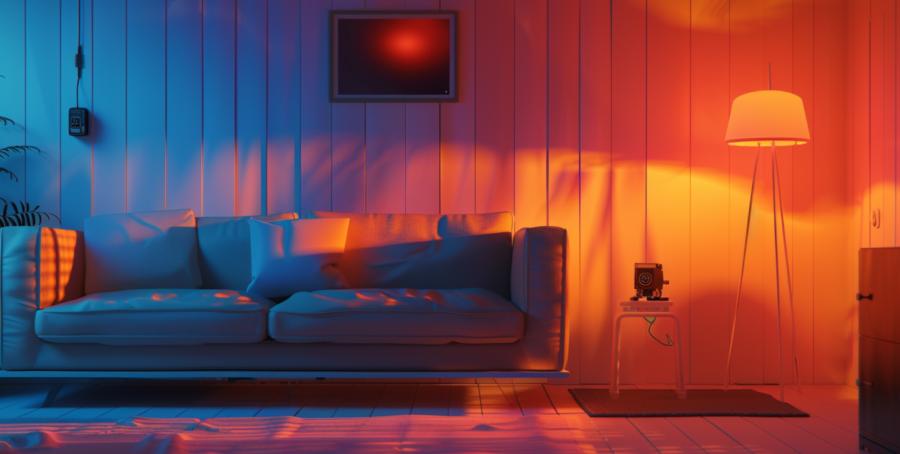What Thermography Actually Is
Thermography uses infrared cameras to detect temperature differences in electrical systems. Every wire, switch, and breaker emits heat when carrying current, but faulty or overloaded components stand out by glowing hotter than their well-behaved neighbours. Think of it as the difference between a commuter quietly scrolling their phone on a bus, and the one person who insists on singing along to whatever’s leaking from their headphones—you notice them straight away.In practice, a thermographic survey captures images of your electrical distribution, highlighting those suspiciously warm patches. Unlike a human hand gingerly hovering near a socket, the camera can see differences of a fraction of a degree. That makes it more than just impressive gadgetry; it’s a predictive tool for preventing equipment failure, power outages, or entire office floors going dark mid-spreadsheet.
What Can Go Wrong Without It
Electrical faults rarely announce themselves politely. Instead, they manifest as flickering lights, scorched sockets, or—at their worst—smoke and sirens. By the time these symptoms appear, the damage is either expensive, dangerous, or both. A loose terminal screw inside a distribution board, for example, can build up resistance. Resistance creates heat. Heat escalates until the board itself is hot enough to fry something far less appealing than an egg.Thermographic surveys are designed to catch these conditions early. A single hotspot in a thermal image can reveal that a circuit breaker is working harder than its neighbours, or that a phase imbalance in a three-phase system is nudging wires into meltdown territory. In other words, the survey transforms “business as usual” into “you might want to fix this before next Tuesday.”
Tools of the Trade
Infrared cameras come in a range of flavours, from handheld devices that look like futuristic camcorders to heavy-duty rigs designed for industrial inspections. At the entry level, they’re straightforward enough: point, shoot, and watch as your electrics bloom into neon shades of yellow, red, and violet.Professionals often use high-resolution models with sensitive sensors, able to distinguish the difference between a component running at 37.2°C and one at 37.8°C. That decimal place matters when diagnosing whether your switchgear is merely warm from use or quietly plotting sabotage. Accessories may include tripods for steady imaging, software to annotate and record findings, and occasionally safety gear—because standing too close to live gear without it is a short-lived career choice.
Interpreting the Pictures
The colourful images can feel like modern art, but there’s no prize for abstract appreciation. Hotspots usually appear in shades of white, yellow, or deep red, while cooler components sit in darker tones. It’s tempting to panic at every bright patch, but context is key. For example, transformers naturally run warmer than cabling, and a motor’s casing may show heat that’s perfectly within operating range.This is why interpretation matters as much as the camera itself. Trained inspectors read these images against the background of system load, design, and environment. One breaker glowing hotter than the others in the same row? Suspicious. A wiring run glowing like a toaster despite low load? Definitely suspicious. An entire panel evenly warm? That might be exactly how it should be.
Everyday Benefits You Don’t Expect
The obvious appeal of a thermographic survey is fire prevention, but the spin-off benefits are worth noting. Downtime in commercial spaces costs money, and surveys can pinpoint problems before they shut down production lines or leave entire offices working by candlelight. For facility managers, it also provides a neat piece of evidence when budget approval is needed: nothing loosens purse strings like a thermal image of a cable glowing like magma.There’s also the question of safety. An unnoticed hot connection can escalate rapidly, turning a quiet corridor cupboard into the most dramatic feature of the building. Having a report in hand means technicians can intervene without guesswork, targeting the precise point of weakness rather than dismantling systems on hunches and prayers.
How Often Should You Do It
Surveys aren’t a once-in-a-lifetime event. Electrical systems change over time—loads increase, components wear, and even the best installations can loosen with vibration and temperature shifts. For commercial and industrial buildings, annual or biannual surveys are common practice. Residential properties might not require the same frequency, but they benefit from inspections when adding new systems or after significant renovations.Think of it like a medical check-up: waiting until something feels wrong is riskier, more expensive, and significantly less dignified. Regular thermographic inspections catch the equivalent of raised cholesterol before it becomes a heart attack.
What Happens After the Survey
Once the thermal images are captured, the findings are compiled into a report. This isn’t coffee-table material—it’s a list of potential disasters ranked by urgency. A competent inspector will flag which components need immediate attention, which are tolerable for now, and which are just doing their job.The report becomes a working document for maintenance teams. It allows electricians to tighten connections, replace breakers, or balance phases with surgical precision. Instead of treating electrics as a mysterious black box, the survey converts invisible heat signatures into actionable steps.
- Critical issues: repair immediately, before smoke chooses your décor.
- Warning signs: schedule repairs soon, before irritation turns to combustion.
- Normal readings: keep an eye on them, but they’re behaving themselves.
Hot Takes on Cool Savings
Here’s the twist: thermographic surveys often save more money than they cost. By avoiding emergency call-outs, equipment damage, and downtime, the return on investment is significant. Insurance companies sometimes even look favourably on businesses with a regular inspection routine. Preventing a blaze is cheaper than rebuilding half an office block, not to mention less embarrassing when explaining to shareholders why the conference room now looks like a charcoal briquette.Thermography also extends equipment life. Components running slightly too hot wear out faster, and catching that early means replacements happen on schedule rather than mid-crisis. That translates into calmer maintenance planning and far fewer late-night phone calls to reluctant electricians.
Wiring Up a Punchline
Thermographic surveys are a way of peeking into the hidden emotional life of your electrics. They sulk, overheat, and occasionally throw tantrums, but with an infrared eye you catch them in the act. It isn’t witchcraft; it’s applied physics, and it’s one of the few times staring at a screen full of alarming colours can actually prevent disaster rather than cause it.In a world where power is as critical as plumbing, seeing the unseen is no indulgence. It’s maintenance, safety, and foresight wrapped into one. And while the camera may render your fuseboard in psychedelic glory, what it really shows is peace of mind—and the priceless knowledge that your wires aren’t planning a pyromaniac surprise party behind the drywall.
Article kindly provided by mecontractors.co.uk


